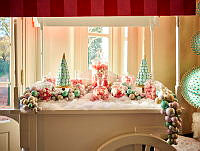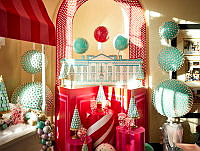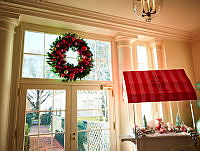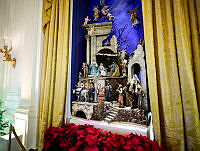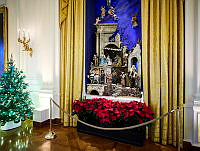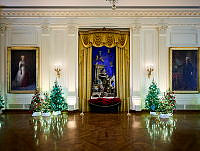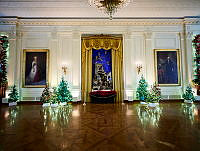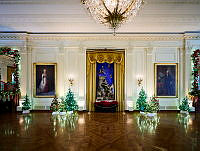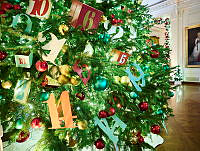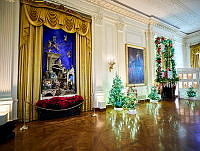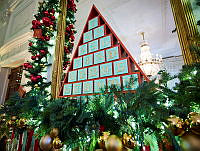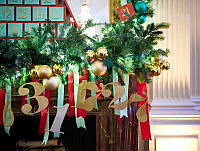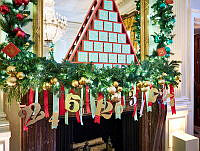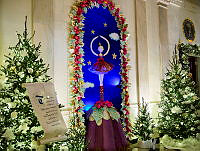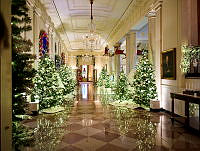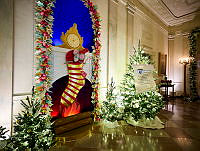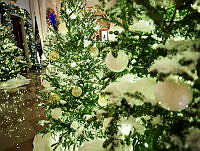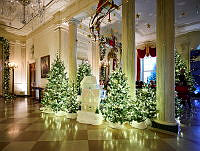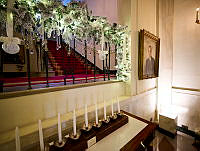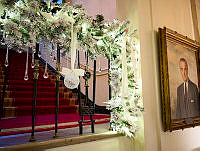Rubenstein Center Scholarship
Sculpture, Bribery, and the Founding Fathers
The Curious Tale of Giuseppe Ceracchi
During his short time in America, Italian neoclassical sculptor Giuseppe Ceracchi created approximately thirty-six marble busts of prominent men including Benjamin Franklin, Alexander Hamilton, Thomas Jefferson, and George Washington, earning him a place as one of the most prolific sculptors in early American history. In particular he is known for a neoclassical bust of George Washington, currently part of the Metropolitan Museum of Art’s collection. With exception of sculptor Jean-Antoine Houdon, Ceracchi is the only other artist known to have modeled George Washington during his lifetime. A marble variant of this sculpture is also part of the White House Collection. It was purchased for the White House in 1817, alongside marble busts of Amerigo Vespucci and Christopher Columbus. Giuseppe Ceracchi’s prolific sculpting of influential American figures occurred during a period of nation-building for the young country. His story started with a failed monument bid and ultimately escalated to issues of bribery, artistic fraud, and national identity.

Drawing of sculptor Giuseppe Ceracchi by etcher Albert Rosenthal. The drawing was modeled after a 1792 portrait by John Trumball.
Library of CongressOn August 7, 1783, the Continental Congress unanimously passed a resolution “that an equestrian statue of General Washington be erected at the place where the residence of Congress shall be established…in honor of George Washington, the illustrious commander-in-chief of the armies [of the United States of America], during the war which vindicated and secured their liberty, sovereignty, and independence.”1 As the United States grappled with its new identity as a nation, Americans put forth different ideas about nation-building. At the time of the resolution, many agreed that symbolism, art, and monuments were crucial to building an American identity.2 Nearly a decade later, Ceracchi arrived in Philadelphia, determined to receive the congressional commission for the equestrian monument of Washington outlined in the 1783 proposal.3
In July 1791, the passionate artist sent a description of the monument to Secretary of State Thomas Jefferson, assuring Jefferson he did not seek financial reward from the project.4 As a renowned supporter of neoclassical art and architecture, Ceracchi knew Jefferson would be an important ally in receiving a commission from Congress. Several months later, on October 31, 1791, Ceracchi submitted his plan to Congress. He titled the work a “Monument designed to perpetuate the Memory of American Liberty,” and included a lengthy description. At its center, the ornate sculpture featured a sixty-foot equestrian statue of George Washington cast in bronze, surrounded by four allegorical groups. These groups included the Roman gods Neptune, Minerva, Mars, and Apollo, a figure representing “Benevolent Nature,” and a figure representing “the Triumph of America.” According to Ceracchi’s plan these surrounding allegorical figures were to be fifteen feet tall and created from “the finest Italian Marble.”5
Ceracchi wasted little time waiting for Congress to consider his proposal. He seized several opportunities to advertise and garner support for his project. On the same day of his letter to Congress, Ceracchi also sent a copy of the plan to President George Washington writing, “Sir, I take the liberty to enclose to you a Copy of a Memorial which I have the honor of presenting this day to Congress—Give me leave to submit it to the Friend and Patron of the fine Arts as well as to the President of the United States.”6 The self-promoting artist also placed a six-foot terra-cotta model of the project on display at Oeller’s Hotel in Philadelphia, a popular destination for Philadelphians and visitors in the 1790’s.7

This marble bust of explorer Christopher Columbus was originally modeled in terra-cotta by Italian sculptor Giuseppe Ceracchi. The bust was acquired by the United States government in 1817 during the James Monroe administration.
White House Collection/White House Historical AssociationDespite Ceracchi’s ambitious plans, Congress was slow to respond to the proposal. On December 6, 1791, the House of Representatives passed a resolution which appointed the committee of Egbert Benson, William Smith, and Elbridge Gerry to determine the best way to implement the resolution of 1783. This was meant to be a joint committee with the Senate, but the Senate failed to act on the proposal.8 Ceracchi saw this resolution as an opportunity to carry out a scheme designed to flatter any man in Philadelphia who might be considered influential enough to advance his proposal. He began modeling busts of important men residing in the city. In fact, Ceracchi modeled committee members Benson and Smith, revealing to everyone his rather brash tactic of flattery.9
Despite these obvious attempts at artistic bribery, most sat willingly for the sculptor. However, some were wary of these sittings, including President Washington who later recalled that he agreed to sit for the sculptor, “with the reluctance that he always felt on these occasions.”10 In addition to the sittings, Ceracchi attempted to gift Washington a pair of marble busts depicting Greek mythology characters Ariadne and Bacchus. Washington declined this gift, imploring Ceracchi to take the busts back.11 Ceracchi instead asked Washington to display them at his Philadelphia residence until he could find the sculptures a new home.12 On the other hand, North Carolina representative Hugh Williamson refused to sit for Ceracchi and wrote a scathing response to the request for a sitting: “Mr. Williamson could not possibly suppose that Mr. Ceracchi had offered such a compliment by way of a bribe; for the man in public station who could accept of a bribe, or betray his trust ought never to have his likeness made, except from a block of wood.”13
Undeterred, Ceracchi continued to sculpt terra-cotta pieces as molds for future marble iterations. By April 1792, it became clear that Ceracchi’s bid for the monument had stalled as such a monarchial display of power and memorial was debated by representatives. This large statue, created in a similar style to images and statues of King George III torn down in the American Revolution, was a contradiction to the American republicanism emerging in the 1790s. Some were opposed to its political imagery, objecting to images of George Washington on coinage and in public spaces. Others strongly supported this imagery. The original architect of the new federal district, Pierre (Peter) Charles L’Enfant, included a location for such a statue in his 1791 plans, while Jefferson also supported this type of monument.14 Despite this support, most believed the design was too large, too expensive, and did not adequately reflect republican values. On April 11, 1792, commissioners from the newly established federal district of Washington D.C. wrote to Jefferson, “We are of opinion that in the application of the funds we ought to class our Work into Necessary, Useful and Ornamental, prefering them in that order. Without going into the Question of right to apply the money to defray the expence of Mr. Cerachi’s Design, or the propriety of the design itself, we decline going into that business.”15 On May 7, 1792, the House of Representatives delivered a similar verdict and on May 16, 1792 the Senate also decided not to pursue the monument.16
Ceracchi returned to Europe but continued to advance his cause, writing letters to Washington, Jefferson, James Madison, and Alexander Hamilton inquiring about the future of the monument. In order to address concerns about a monument of George Washington built during his presidency, Ceracchi replaced the figure of Washington with the Goddess of Liberty.17 He also began to model marble busts from his earlier terra-cotta forms. He wrote to Jefferson on March 27, 1793: “I shall have then the plaesure to cut your bust in marbre, and present it to you as a patern of my cisel and a little mark of my estime.”18 During this time period Ceracchi also created marble busts of Washington and Hamilton and life-size profiles in high relief of John Adams and James Madison.19

This marble bust of President George Washington was originally modeled in terra-cotta circa 1790-1794 by Italian Sculptor Giuseppe Ceracchi. The bust was acquired by the United States government in 1817 during the James Monroe administration.
White House Historical Association/White House CollectionWhen he returned to Philadelphia in the fall of 1794, Ceracchi continued to pursue the monument but faced a mounting resistance. As costs were estimated to total $300,000, a staggering sum for a fledgling country with a pressing revenue problem, the likelihood of any politician supporting his cause diminished rapidly.20 Ceracchi knew that currying favor with politicians was essential to his project’s advancement, so he continued modeling portraits. Ceracchi contacted President Washington again to ask for more sittings because alterations were required for the marble bust. Washington allowed the sittings and when it was completed Ceracchi left the bust in Washington’s residence, along with his previous sculptures of Ariadne and Bacchus. When Ceracchi hinted that the bust was a gift for First Lady Martha Washington, Washington stated that they could not accept it as a gift. However, Ceracchi did gift completed marble portraits to others sculpted, including Alexander Hamilton and James Madison.21
Because the government could no longer sponsor the monument, Ceracchi devised a subscription campaign in early 1795. Ceracchi held a meeting at his home and invited a number of potential patrons to fund his project. He was supported by some sixty sponsors including Washington, Madison, Alexander Hamilton, Aaron Burr, former Secretary of War Henry Knox, Secretary of State Edmund Randolph, and Pennsylvania senator Robert Morris. Ceracchi sought to obtain one thousand yearly subscriptions at thirty six dollars a share. Although it is unknown how many bought shares, President Washington took four shares and pledged to continue the subscription for ten years.22 Unfortunately for the artist, the subscription plan failed and the managers of the fund advised Ceracchi to return subscription shares.
When Ceracchi finally realized that his monument plans would never come to fruition, he became angry and sent irascible letters demanding payment to all those that had accepted his gifts of marble statuary, including Washington, Jefferson, and Madison. Some, including Madison, agreed to pay for Ceracchi’s gifts. Madison later wrote sympathetically about the debacle, believing that Ceracchi’s demands of reimbursement “were not the effect of avarice of his wants, all his resources having been exhausted in the tedious pursuit of his object.”23 Others, including George Washington, did not share Madison’s sympathy for Ceracchi.
In his letter to Washington, Ceracchi demanded payment for the statuary on loan at the president’s Philadelphia residence stating: “I am absolutely convinced that I have been infamousely duped by all those persons who have been the busi body of the subscription plan, therefore I must withdrow my self from this scandalous bisiniss.” 24 Upon receiving no reply from Washington, the artist sent another letter, this time riddled with anger and disappointment, “Sir, Longer I remain in this country and grossely I am abused—why then? because I demand the price of my works.”25
After receiving these letters Washington composed a long draft response to the struggling artist which was edited, sent, and signed by Washington’s secretary and Martha Washington’s nephew, Bartholomew Dandridge, Jr.26 This diplomatic response reminded Ceracchi of Washington’s reluctance to sit for a bust and his refusal in 1792 to accept the marble statues of Ariadne and Bacchus as gifts. Dandridge also denied that Washington had agreed to the gift of his own bust, writing of the sitting, “it was for purposes of your own it was wanted until hints were given that it was designed to presented to Mrs. Washington—therefor the first time he knew & declared that he could not, and would not accept it as a present.”27 Ceracchi composed another bitter response to Dandridge’s letter demanding the return of the statue which the disgraced artist then sold for two thousand dollars to Jose de Jaudenes y Nebot, the Spanish Minister from the court of Madrid.28

This marble bust of explorer Amerigo Vespucci was originally modeled in terra-cotta by Italian sculptor Giuseppe Ceracchi. The bust was acquired by the United States government in 1817 during the James Monroe administration.
White House Collection/White House Historical AssociationThe question remains: after the controversy and fall out between the two men, how did a bust of Washington end up in the White House Collection? Ceracchi returned to Europe in late 1795, where his misfortune continued. Although he found success as an artist in Paris and started a colossal bust of Napoleon in 1796, he joined the radical anti-Bonapartists after Napoleon’s 1799 coup d’état. He was arrested on November 11, 1800, for his participation in an assassination plot against Napoleon at the Paris Opera and was executed by guillotine on October 11, 1801.29
Meanwhile, Ceracchi’s numerous busts changed hands throughout the United States and Europe. Many of his works were modeled on the original but carved by others. It is known that variations of the Ceracchi bust were produced in Italy during the first half of the nineteenth century after Ceracchi left his terra-cotta busts to the Florentine Pisini brothers before returning to America in 1794.30 The Washington bust came to the White House Collection alongside busts of Italian explorers Amerigo Vespucci and Christopher Columbus. Ceracchi likely modeled these latter works in terra-cotta before 1794 when he left the terra-cotta models to the Pisini brothers.31 In 1816, Washington’s former secretary Tobias Lear purchased “6 marble busts if Washington, Vespucius & Colombus” for eighty dollars apiece from Thomas Appleton, the U.S. Consul at Livorno, Italy. According to art historian Philipp Fehl, these busts were carved by Raimondo Trentanove who passed off his work as Ceracchi busts.32 On October 11, 1816, Lear tragically committed suicide, leaving the busts in possession of his son Benjamin L. Lear. A few months later in May 1817 he sold the figures to the government for one hundred dollars each. This purchase may have been orchestrated by President James Monroe, a friend of Ceracchi’s who was looking for new furnishings for the nearly rebuilt White House.33
It is unclear whether those completing the purchase were aware of the fallout between Ceracchi and Washington. However, the bust’s purchase by the government and display within the White House serves as an ironic reminder of Ceracchi’s impact on the newly created United States. The White House Collection seeks to feature many extraordinary pieces of art which highlight America’s artistic heritage and the history of the residence and their occupants. These marble depictions of Washington, Columbus, and Vespucci certainly reflect this rich legacy. Despite Ceracchi’s struggles, his busts were deemed worthy of display in the White House and represent the struggles of the Founding Fathers to create a national identity while adhering to revolutionary principles.

This 1962 photograph by Bates Littlehouse captures the marble bust of George Washington atop a gilded and carved beechwood table by Pierre-Antoine Bellangé. The table and bust appeared in the Blue Room during the John F. Kennedy Administration.
White House Historical Association














